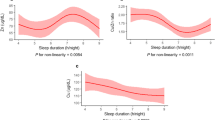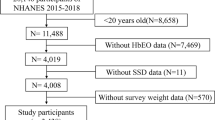Abstract
The existing evidence on the relationships of serum zinc, copper, and zinc/copper ratio with sleep duration is limited and conflicting. The present cross-sectional study aimed to investigate these associations in general adults by utilizing data from the 2011–2016 National Health and Nutrition Examination Survey. The concentrations of zinc and copper were measured in serum samples. Sleep duration (self-reported usual sleep duration) was categorized as < 7 h/night (short sleep duration), 7–8 h/night (optimal sleep duration), and > 8 h/night (long sleep duration). Multinomial logistic regression models and restricted cubic splines were constructed to examine the associations of serum zinc, copper, and zinc/copper ratio with sleep duration. A total of 5067 adults were included. After multivariate adjustment, compared with the optimal sleep duration group, the odds ratios (ORs) (95% confidence intervals, CIs) in the long sleep duration group for the highest versus lowest quartile of serum zinc concentration and zinc/copper ratio were 0.61 (0.39–0.96) and 0.58 (0.38–0.89), respectively. Furthermore, among males, the OR (95% CI) of long sleep duration for the highest versus lowest quartile of serum copper concentration was 2.23 (1.15–4.32). Finally, the dose–response trends suggested that participants with optimal sleep duration had the highest serum zinc concentration and zinc/copper ratio and a slightly lower serum copper concentration. No significant association was found between serum zinc, copper concentrations and the zinc/copper ratio and short sleep duration. In conclusion, serum zinc and zinc/copper ratio were inversely related to long sleep duration in adults, while serum copper was positively associated with long sleep duration in males.



Similar content being viewed by others
Data availability
Data will be made available on responsible request.
Code Availability
Not applicable.
References
Kirszenblat L, van Swinderen B (2015) The yin and yang of sleep and attention. Trends Neurosci 38:776–786. https://doi.org/10.1016/j.tins.2015.10.001
Meng L, Zheng Y, Hui R (2013) The relationship of sleep duration and insomnia to risk of hypertension incidence: a meta-analysis of prospective cohort studies. Hypertens Res 36:985–995. https://doi.org/10.1038/hr.2013.70
Ayas NT, White DP, Al-Delaimy WK, Manson JE, Stampfer MJ, Speizer FE, Patel S, Hu FB (2003) A prospective study of self-reported sleep duration and incident diabetes in women. Diabetes Care 26:380–384. https://doi.org/10.2337/diacare.26.2.380
Hoevenaar-Blom MP, Spijkerman AM, Kromhout D, Verschuren WM (2014) Sufficient sleep duration contributes to lower cardiovascular disease risk in addition to four traditional lifestyle factors: the MORGEN study. Eur J Prev Cardiol 21:1367–1375. https://doi.org/10.1177/2047487313493057
Yin J, Jin X, Shan Z, Li S, Huang H, Li P, Peng X, Peng Z, Yu K, Bao W, Yang W, Chen X, Liu L (2017) Relationship of sleep duration with all-cause mortality and cardiovascular events: a systematic review and dose-response meta-analysis of prospective cohort studies. J Am Heart Assoc 6https://doi.org/10.1161/jaha.117.005947
Hublin C, Partinen M, Koskenvuo M, Kaprio J (2007) Sleep and mortality: a population-based 22-year follow-up study. Sleep 30:1245–1253. https://doi.org/10.1093/sleep/30.10.1245
Juhász G, Kékesi K, Emri Z, Soltesz I, Crunelli V (1990) Sleep-promoting action of excitatory amino acid antagonists: a different role for thalamic NMDA and non-NMDA receptors. Neurosci Lett 114:333–338. https://doi.org/10.1016/0304-3940(90)90586-x
Campbell IG, Gustafson LM, Feinberg I (2002) The competitive NMDA receptor antagonist CPPene stimulates NREM sleep and eating in rats. Neuropsychopharmacology 26:348–357. https://doi.org/10.1016/s0893-133x(01)00363-3
Livingstone C (2015) Zinc: physiology, deficiency, and parenteral nutrition. Nutr Clin Pract 30:371–382. https://doi.org/10.1177/0884533615570376
Williams DM (1983) Copper deficiency in humans. Semin Hematol 20:118–128
Peters S, Koh J, Choi DW (1987) Zinc selectively blocks the action of N-methyl-D-aspartate on cortical neurons. Science 236:589–593. https://doi.org/10.1126/science.2883728
Vlachová V, Zemková H, Vyklický L Jr (1996) Copper modulation of NMDA responses in mouse and rat cultured hippocampal neurons. Eur J Neurosci 8:2257–2264. https://doi.org/10.1111/j.1460-9568.1996.tb01189.x
Ji X, Liu J (2015) Associations between blood zinc concentrations and sleep quality in childhood: a cohort study. Nutrients 7:5684–5696. https://doi.org/10.3390/nu7075247
Luojus MK, Lehto SM, Tolmunen T, Elomaa AP, Kauhanen J (2015) Serum copper, zinc and high-sensitivity C-reactive protein in short and long sleep duration in ageing men. J Trace Elem Med Biol 32:177–182. https://doi.org/10.1016/j.jtemb.2015.07.008
Song CH, Kim YH, Jung KI (2012) Associations of zinc and copper levels in serum and hair with sleep duration in adult women. Biol Trace Elem Res 149:16–21. https://doi.org/10.1007/s12011-012-9398-5
Kim NR, Kim KW, Kim HN, Song SW (2018) Associations between serum zinc levels and mental health: findings from the 2010 Korean National Health and Nutrition Examination Survey. Biol Trace Elem Res 181:192–198. https://doi.org/10.1007/s12011-017-1051-x
Centers for Disease Control and Prevention. National Health and Nutrition Examination Survey. https://www.cdc.gov/nchs/nhanes/index.htm. Accessed December 22 2019
Cui Y, Niu K, Huang C, Momma H, Guan L, Kobayashi Y, Guo H, Chujo M, Otomo A, Nagatomi R (2015) Relationship between daily isoflavone intake and sleep in Japanese adults: a cross-sectional study. Nutr J 14:127. https://doi.org/10.1186/s12937-015-0117-x
Beydoun HA, Beydoun MA, Jeng HA, Zonderman AB, Eid SM (2016) Bisphenol-A and sleep adequacy among adults in the National Health and Nutrition Examination Surveys. Sleep 39:467–476. https://doi.org/10.5665/sleep.5466
Centers for Disease Control and Prevention, National Health and Nutrition Examination Survey, Laboratory Procedure Manual, Zinc, Copper and Selenium. https://wwwn.cdc.gov/nchs/data/nhanes/2011-2012/labmethods/cusezn_g_met_serum_elements.pdf. Accessed June 10 2020
Kroenke K, Spitzer RL, Williams JB (2001) The PHQ-9: validity of a brief depression severity measure. J Gen Intern Med 16:606–613. https://doi.org/10.1046/j.1525-1497.2001.016009606.x
Centers for Disease Control and Prevention, Continuous NHANES Web Tutorial. https://www.cdc.gov/nchs/tutorials/NHANES/index_continuous.htm. Accessed 12 October 2019
Roehrs T, Kapke A, Roth T, Breslau N (2006) Sex differences in the polysomnographic sleep of young adults: a community-based study. Sleep Med 7:49–53. https://doi.org/10.1016/j.sleep.2005.05.008
Bhatnagar S, Taneja S (2001) Zinc and cognitive development. Br J Nutr 85(Suppl 2):S139-145. https://doi.org/10.1079/bjn2000306
Kostin A, Alam MA, McGinty D, Szymusiak R, Alam MN (2019) Chronic suppression of hypothalamic cell proliferation and neurogenesis induces aging-like changes in sleep-wake organization in young mice. Neuroscience 404:541–556. https://doi.org/10.1016/j.neuroscience.2019.01.053
Zhang HQ, Li N, Zhang Z, Gao S, Yin HY, Guo DM, Gao X (2009) Serum zinc, copper, and zinc/copper in healthy residents of Jinan. Biol Trace Elem Res 131:25–32. https://doi.org/10.1007/s12011-009-8350-9
Acknowledgements
We would like to thank Prof. Dongfeng Zhang for his help in data analysis.
Funding
This work was supported by the grants from the National Natural Science Foundation of China (81200872).
Author information
Authors and Affiliations
Contributions
Y.J. was responsible for acquisition of data, data analysis and drafting the article.
J.S. was responsible for acquisition of data and data analysis.
L.C. was responsible for revising the article critically.
Y.X. was responsible for financial support and final approval of the version to be submitted.
Corresponding author
Ethics declarations
Ethics Approval
The Research Ethics Review Board of the National Center for Health Statistics authorized the survey protocol, and all participants provided informed consent.
Consent to Participate
Not applicable.
Consent for Publication
Not applicable.
Conflict of Interest
The authors declare no competing interests.
Additional information
Publisher's Note
Springer Nature remains neutral with regard to jurisdictional claims in published maps and institutional affiliations.
Supplementary Information
Below is the link to the electronic supplementary material.
Rights and permissions
About this article
Cite this article
Jia, YN., Sun, J., Chen, L. et al. Associations of Serum Zinc, Copper, and Zinc/Copper Ratio with Sleep Duration in Adults. Biol Trace Elem Res 200, 2651–2659 (2022). https://doi.org/10.1007/s12011-021-02897-7
Received:
Accepted:
Published:
Issue Date:
DOI: https://doi.org/10.1007/s12011-021-02897-7




